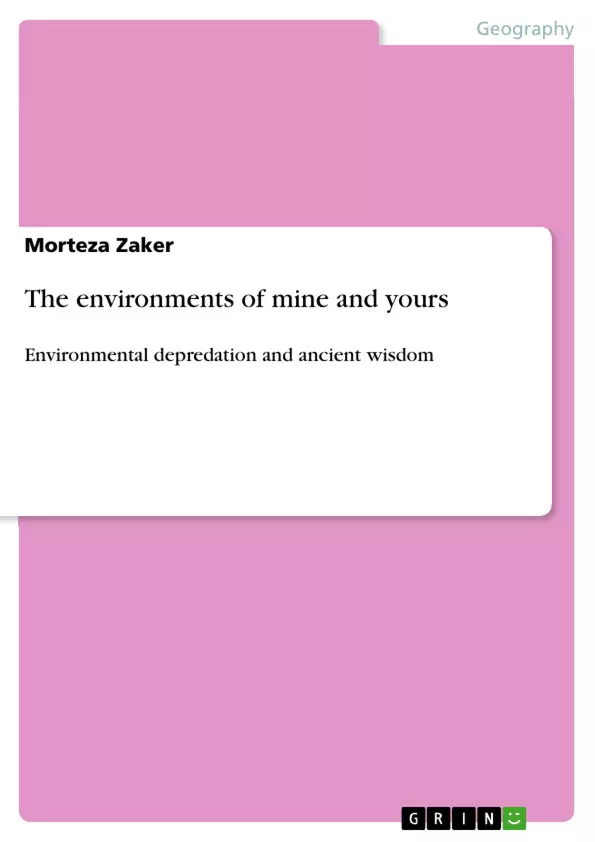The purpose of this book is to investigate the issue of environmental economics and also Environmental crisis and destruction. Evaluation of development plans can be reviewed from three perspectives. One in terms of the number of environmental reviews in the papers, secondly, in terms of quality and scientific approaches to programs, and ultimately the effectiveness of approaches.
Inhaltsverzeichnis (Table of Contents)
- Environment history
- Environmental activists
- Environmental Crisis
- Urmia Lake
- Golestan forest
- Pollution in persian gulf
- Anzali lagoon
- Dust pollution in khuzistan
Zielsetzung und Themenschwerpunkte (Objectives and Key Themes)
This book aims to examine the environmental governance practices in Iran, particularly focusing on the country's laws and development plans. It explores the historical context of environmental protection in Iran and analyzes the country's environmental indicators to assess public attitudes towards environmental degradation. The text also examines the effectiveness of environmental policies and legislation in Iran, taking into account the relationship between economic development and environmental protection.
- The history of environmental protection in Iran
- The relationship between economic growth and environmental degradation
- The role of public perception and awareness in environmental governance
- The effectiveness of environmental policies and legislation in Iran
- The impact of resource extraction and industrialization on the environment
Zusammenfassung der Kapitel (Chapter Summaries)
- Chapter 1: Environment History: This chapter explores the historical development of environmental protection in Iran, starting with the introduction of wildlife protection laws in 1928 and the establishment of the Environmental Protection Agency in 1972. It delves into the evolution of the concept of "environment" in Iranian law and the various factors that have shaped environmental policy over the decades.
- Chapter 2: Environmental Activists: This chapter analyzes the role of environmental activists in Iran and their contributions to raising awareness about environmental issues and advocating for stronger environmental protection measures.
- Chapter 3: Environmental Crisis: This chapter examines the current environmental challenges faced by Iran, such as pollution, deforestation, and resource depletion. It analyzes the causes of these problems and their impact on human health and the environment.
- Chapter 4: Urmia Lake: This chapter focuses on the environmental crisis of Urmia Lake, a vital ecosystem that has been severely impacted by drought and pollution. It examines the causes of the lake's decline and explores potential solutions for its rehabilitation.
- Chapter 5: Golestan Forest: This chapter examines the environmental challenges faced by Golestan Forest, a crucial natural resource that is under threat from deforestation and illegal logging. It analyzes the impact of these activities and discusses strategies for conservation and sustainable management.
- Chapter 6: Pollution in the Persian Gulf: This chapter explores the sources of pollution in the Persian Gulf and their impact on marine ecosystems and human health. It examines the role of oil spills, industrial waste, and other pollutants in degrading the Gulf's environment.
- Chapter 7: Anzali Lagoon: This chapter examines the ecological significance of Anzali Lagoon, a vital wetland area facing threats from pollution and invasive species. It explores the causes of these challenges and discusses efforts to protect and restore the lagoon.
- Chapter 8: Dust Pollution in Khuzestan: This chapter analyzes the problem of dust storms in Khuzestan province, a region that experiences severe air pollution from dust originating in Iraq and other countries. It examines the causes of dust pollution and its impact on human health and the environment.
Schlüsselwörter (Keywords)
The main focus of this book is on environmental governance, particularly in the context of Iran. Key themes include the history of environmental protection in Iran, environmental indicators, economic development and environmental degradation, public perception of environmental issues, and the effectiveness of environmental policies and legislation.
- Citar trabajo
- Morteza Zaker (Autor), 2019, The environments of mine and yours, Múnich, GRIN Verlag, https://www.grin.com/document/494033



